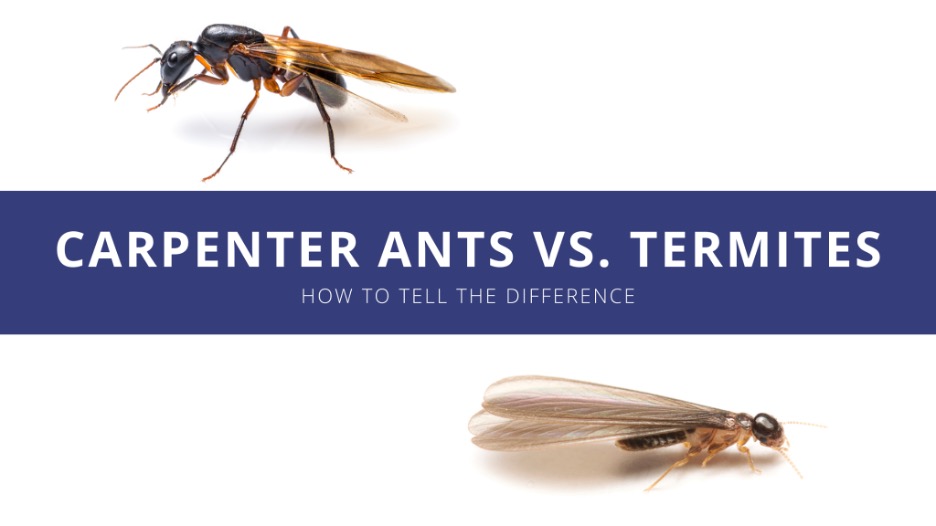Although they may look different to the trained eye, termites and carpenter ants do share common features, characteristics, and behavior—making these insects difficult to tell apart for the average home or business owner. Knowing the signs of carpenter ants versus termites is especially important when it comes to identifying a pest infestation, because both destroy wood around homes and businesses, weakening or completely ruining parts of your building’s structure before you know it.
Get A Free Quote
Inquiries
(800) 236-8735
Whether you’ve already spotted one of these pests or simply want to prevent an infestation, compare, and contrast the traits of termites vs. carpenter ants with these tips from Terminix Wil-Kil Pest Control.
How to Identify Carpenter Ants
Carpenter ants look similar to the average, dark-colored ants that Midwesterners most commonly see. They tend to be bigger, though, and the male swarmers have wings. As a nocturnal species, the carpenter ant will forage for food at night, which is when homeowners are most likely to see them out and about. Otherwise, it can take years to even detect visible damage from carpenter ants, as they gnaw away at wood slower than their termite counterparts.
How to Prevent Carpenter Ants
Usually, you can help control a carpenter ant infestation by eliminating conditions that are attracting them to your home: Carpenter ants are drawn to moisture, such as damp or damaged wood, pools of standing water, and even sweet foods. They do not actually eat wood, they just nest in it, so they might gravitate to other food sources if they find easy entry points.
Several steps you can take to get rid of and prevent carpenter ants in your space include:
- Storing any wood piles, scraps, or decaying matter away from your home’s entry points or foundation
- Removing tree limbs, stumps, or other potential nesting sites from your yard
- Closing any cracks or entry points inside and outside your home (tears in window screens, openings under porches, gaps under doors and baseboards, etc.)
- Sealing and repairing any plumbing leaks in your roof or crawl space
- Eliminating sites of excess moisture accumulation inside and outside (basements, kitchens, gutters, plants, etc.)
How to Identify Signs of Termites
Compared to carpenter ants, you are more likely to notice signs of termite presence than you are to actually spot the insects themselves. Any wood damage, detached wings, insect droppings, or “mud tubes” can all be indicators of a termite infestation. In particular, subterranean termites build mud tubes along wall exteriors or between soil and wood. These trails of mud protect them from exposure, allowing termites to travel to and from food sources on your property.
Preventing Termite Infestations Around Your Home
The best remedy for a termite problem is prevention. Doing everything you can to remove conditions from in and around your home is key. Remove any lumber, wood, mulch, or other debris from around your home’s foundation. Occasionally check wooden fencing outside the home for rotting or signs of damage.
In addition to wooden items, keeping plants such as shrubs and bushes set away from your home by at least a foot can help improve airflow and make termite mud tubes easier to spot. Grass should be cut short and raked to keep it from accumulating around your foundation, too. In addition, this will help mitigate the presence of moisture around your foundation—a common invitation to termites and other insects.
Even if you do everything else right, there’s still a chance that termites might make their way to your home. That’s why annual termite inspections are important.
Control Termite or Carpenter Ant Infestations with Terminix Wil-Kil
To completely get rid of wood-destroying termites or carpenter ants around your house or commercial building, you’ll first want to remove all possible conditions conducive to their survival. However, the presence of termites needs to be taken seriously, as the resulting damage can be extremely costly to homeowners.
Don’t count on DIY pest control methods to stand up to major ant or termite infestations. Proper termite control measures require intervention from your local pest professionals. Providing pest control throughout Wisconsin, Terminix Wil-Kil is here to help with your termite or carpenter ant problem. Contact us today to reclaim your space from pests!
Carpenter Ants vs. Termites in Sun Prairie, WI
Terminix Wil-Kil Pest Control is a local Pest Control and Extermination company helping homeowners and businesses with pest issues across WI.

